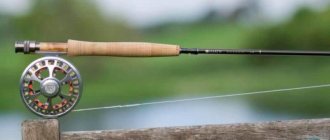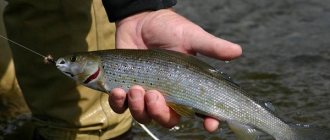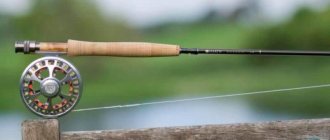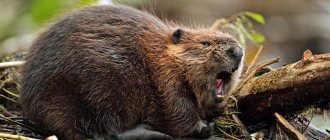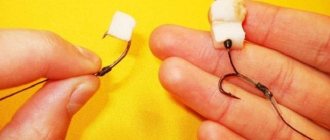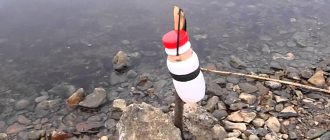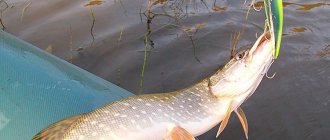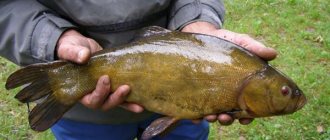Spring fishing for grayling is a very exciting and dynamic activity, the result of which, with the right approach, can be quite a decent catch. This fish lives in reservoirs with clean, cool water, a sandy or rocky bottom and medium/fast current. Grayling is highly active after the end of spawning, which takes place in March-April. During this period you need to go fishing.
In the case of fishing on small rivers, which will be discussed in this article, you should not wait to catch large specimens weighing 1.5-2 kg. As a rule, in small reservoirs you usually come across specimens with a weight of about 300-500 g and a length of 25-30 cm, much less often - grayling under 800-900 g.
Tackle for grayling fishing
Due to the fact that small forest rivers most often have fairly overgrown banks and are quite small in width, spinning fishing becomes relevant in such conditions. Therefore, first of all, you will need a good ultralight or light rod of medium-fast action with a test value of 5-7 g. The spinning rod should not be too hard, and in terms of length, you should give preference to models of 2.1-2.3 m.
The second important element is a strong spinning reel with a spool size of 2000-2500 and a high-quality front drag. It is better to wind a monofilament line with a diameter of 0.16-0.18 mm on it, but if possible, it is advisable to have on hand a spare spool with a braided cord with a thickness of about 0.1 mm.
Catching grayling with a float rod
Before moving on to the most difficult sections about fishing for grayling with spinning and fly fishing, I will tell you about fishing with a float rod.
Sometimes it seems that to catch grayling we need a suitcase of money and a lot of knowledge. This is not entirely true. The local population successfully catches grayling with a regular fishing rod; they have no idea about Megabass wobblers and reels for 50 thousand rubles. This method of fishing is available to everyone without exception. Fishing with a fishing rod is the most democratic way!
For fishing we will need: a light fishing rod and a can of worms. All! We can say that you are ready for fishing.
Fishing for grayling in the summer will be whatever you decide. Complex or simple - the choice is yours!
Grayling fishing is carried out before and after the rifts and directly in the rifts themselves. All kinds of return lines, clamps, and lulls become fishing spots. Grayling loves to hide behind large rocks. The fisherman, examining the entire area of the riffle, systematically throws the tackle into promising places. The bite on a float rod is very fast, the float literally dives under the water. At this moment, a gentle hook is made and, without forcing events, the fish is smoothly landed.
One September day we specially went to a kind of duel. Two anglers were fishing on the shallows: one angler armed himself with a spinning rod and the best wobblers, the other with a wire rod. The score of our competition was a draw 3=3.
More about the inhabitants of our reservoirs: chub, ide, pike, perch
1. Wading boots or waders? I undoubtedly consider wading boots to be the best option here, for the sole reason that the depths on small rivers are shallow, and the river can be crossed along shallow riffles, of which there are plenty on such rivers. If you are going to be fishing on a forest river, then the waders can easily be torn while moving through thickets and fallen trees, so wading boots are an optimal and at the same time budget solution.
Spinners
Pinwheels are considered the most catchy spinning bait for catching grayling in the spring. Spinner baits of this type must be small in size and, of course, match the test of the rod, and it is also important that they work stably with any method and speed of retrieving.
When looking through color options, it’s worth focusing on models with silver and golden petals, as well as pinwheels with large red or black dots. Good baits from such famous manufacturers as Mepps, Daiwa and Savage Gear.
Equipment and accessories
Fishing on a small river, especially on a small forest stream, is a process that requires certain equipment, so it is still necessary to say a few words about the equipment and accessories that you should wear and carry with you.
Tips for fisherman: Where is grayling fish found in Russia - Answers for beginners
1. Wading boots or waders? I undoubtedly consider wading boots to be the best option here, for the sole reason that the depths on small rivers are shallow, and the river can be crossed along shallow riffles, of which there are plenty on such rivers. If you are going to be fishing on a forest river, then the waders can easily be torn while moving through thickets and fallen trees, so wading boots are an optimal and at the same time budget solution.
2. As I wrote earlier, when successfully fishing for grayling, it is important to remain quiet and inconspicuous, so the equipment you are wearing should not be provocative. Clothing of a camouflage type or that blends into the environment is the best option; I think it’s ridiculous to dress in all the colors of the rainbow.
Perhaps this is all I wanted to convey to readers in the second part of the article. Catch grayling and be sure to release it back to its native element, since such a beautiful and strong fish is certainly the adornment and pride of small rivers.
Oleg Solomatov, a spinning fishing enthusiast with 10 years of experience
Grayling fishing in spring is as diverse as the nature of Siberian places. Fishing conditions on fast rivers in those harsh and beautiful regions are just as different. Spring fishing is carried out during the grayling's spawning run. This rise to the upper reaches is where fishing is based, which can be very successful. It should only be taken into account that such fishing during the spring run of fish is often very short, only 3–5 days in a given section of the river. And you definitely need to get to these days of productive spring fishing.
Grayling fishing in spring is as diverse as the nature of Siberian places. Fishing conditions on fast rivers in those harsh and beautiful regions are just as different. Spring fishing is carried out during the grayling's spawning run. This rise to the upper reaches is where fishing is based, which can be very successful. It should only be taken into account that such fishing during the spring run of fish is often very short, only 3–5 days in a given section of the river. And you definitely need to get to these days of productive spring fishing.
In places where you come across fairly large grayling, you need to have a landing net with a long handle in stock. It can reach 4 m in length. Large fish simply cannot be lifted ashore by weight.
Catching grayling in the spring with a spinning rod can also be successful, and sometimes trophy specimens are caught. For fishing, small spinners with a special coating and coloring are used. Lures are selected empirically for each specific body of water, but in general they look like in the photo for this article.
Fishing using rotating spoons, also miniature ones, is often very effective. It is the largest grayling that are caught on such small “turntables”. Usually these are baits from zero to first numbers. But you should fish with rotating spoons in relatively quiet places, otherwise the “spinner” simply won’t work.
A bite on such gear is immediately felt and transmitted to the hand through the fishing rod. Having felt a push in the hand, a light hook with the fishing rod is enough for the fisherman to drive the tip of the hook into the lip of the fish. But there are also disadvantages of such equipment, these are hooks and the sinker getting stuck in the rocks at the bottom.
Oscillating spoons
Spoon baits, as a rule, are less effective for grayling, but in relatively calm sections of the river they can also give good results. From the variety of such spinners, choose miniature silver or copper models with an oblong shape and a weight of 5-7 g. When fishing with spoons, it is advisable to use the technique of retrieving with short pauses, because grayling most often attacks the bait precisely when it is in the free fall phase .
Where to look for this fish?
Catching grayling in the spring requires that the angler is well acquainted with the habits of this particular fish. You can catch pike, perch, pike perch or other predator well, but difficulties may arise with grayling. This fish primarily prefers a rocky bottom, somewhat less often a sandy bottom. Almost never found in grassy areas. The search for this fish is especially promising near rifts and rapids on rivers, and in rocky shallow areas of lakes.
Photo 1. In places where rivers narrow, promising rapids appear.
There is also an interesting pattern - the higher up the river you fish, the larger the grayling you catch.
Which, however, is quite simply explained. When climbing up the riverbed, against the current (often quite strong), the fish has to expend a lot of energy, and the small grayling is simply unable to go against the current for a long time. Important! Grayling is a schooling fish; where one was caught, there are most likely a couple more. Often such schools consist of fish of approximately the same size and age.
Wobblers for grayling
Depending on the strength of the current, various models can be used, but ideally it is better to take sinking baits. The sizes of wobblers for catching grayling in small rivers are also very modest - about 3-5 cm. As for the body shape, cranks and minnows are considered the most catchy.
Fishing for grayling before and after spawning
So, let us immediately note that grayling is a very cautious fish. The slightest danger will force the fish to leave the most promising and richest place for food. Grayling has ideally developed vision and hearing; in addition, the fish has a sensitive lateral line. Grayling can be scared not only by an object falling into the water or a shadow from the fisherman himself, but also by the shadow that will be formed by the fishing rod.
Therefore, if you want to stay with your catch, it is important to try to fish as carefully as possible. Unless absolutely necessary, do not approach the water's edge closer than two meters. When fishing, do not rise to your full height and remain as quiet as possible.
In the upper reaches of rivers, grayling begins to move as soon as the ice melts. Note that this fish cannot tolerate spring floods, which carry turbidity into the water, which is why grayling goes into tributaries, where the water is always clean, the depth is not great and the water warms up faster.
Spawning takes place in areas with a rocky bottom at shallow depths. The best time to catch grayling before the start of spawning is considered to be the period when the fish begins to move up the river to the spawning areas. During the spawning period, grayling does not show activity, but immediately after the bite resumes.
The spawning period of grayling begins as soon as the water temperature in the river reaches +8-10 degrees. This is individual for each reservoir, but on average grayling spawns in mid-May.
Read: Fishing in the Urals
Techniques for catching grayling in spring
A characteristic feature of grayling that distinguishes it from trout is its wait-and-see hunting style. This predator rarely chases a potential prey for a long time, which is why you should definitely try retrieves at a slow pace, as far as the strength of the current allows.
If we consider specific wiring options, we can distinguish three main methods:
- Posting with the flow. In this case, you will need to reel in the line quickly enough so that the bait remains attractive to the fish.
- Wiring against the current. The line is reeled in slowly, with short pauses; the bait gradually presses against the shore. With this option, there is a much greater chance of attracting the interest of spring grayling and provoking the predator to attack.
- Wiring for demolition. The bait is thrown a little higher upstream, after which it is pulled up a little using a reel or rod. Bites occur most often at the stage when the fishing line is at right angles to the direction of the current.
Author of the article: Vitaly Leonidovich Ivanov, 2021.
How long has it been since you had a really BIG CATCH?
When was the last time you caught dozens of HUGE pike/carp/bream?
We always want to get results from fishing - to catch not three perch, but ten kilogram pikes - what a catch! Each of us dreams of this, but not everyone can do it.
A good catch can be achieved (and we know this) thanks to good bait.
It can be prepared at home or bought in fishing stores. But stores are expensive, and to prepare bait at home, you need to spend a lot of time, and, to be fair, homemade bait does not always work well.
You know that disappointment when you buy bait or prepare it at home and only catch three or four bass?
So maybe it’s time to use a truly working product, the effectiveness of which has been proven both scientifically and in practice on the rivers and ponds of Russia?
Of course, it is better to try once than to hear a thousand times. Moreover, now is the season! A 50% discount on your order is a great bonus!
Probably for an hour I tried to find the key to the current situation: I changed the pace of the retrieve, placed spinners of different colors and with different petal shapes, but in the end I still capitulated: I placed a spinner, which, in the color and shape of its petal, almost copied the spinner identically. , which my friend fished with.
Morozov I. | November 12, 2000
If now someone asks me what kind of fish, after the traditional pike and perch and trout, can be caught with a spinning rod without going far from the city, I will answer without hesitation: grayling.
Grayling is a small, beautiful fish that can still be found in many rivers and streams of the Leningrad region, sometimes without even traveling far from the city.
However, “small” is not entirely true: for example, Ladoga graylings that come to spawn in the Nazia River (and other rivers flowing into Ladoga and Neva) can weigh more than a kilogram, and even at a decent distance from the city, for example in the southwest region, grayling can reach considerable weight. For the most part, settled river grayling weighs 100-150 grams. However, hunting for this fish, which is very easily identified by the “flag” on its back, can be a great pleasure for fans of light spinning rods.
Grayling has many similarities with brook trout. Very often these two fish not only live side by side in small rivers, but are also caught in the same places. There were cases when, from under the same snag, I pulled out first grayling and then trout, or vice versa. At the same time, I met grayling in large numbers not only on a calm current, but also on rocky rifts, where it stands behind large stones, thus hiding from the fast current, and on the echoes of streams.
For example, when I come fishing on the river. Sister, then first of all I start looking for him there. In addition, its mooring sites can be identified by small graylings, which in good weather like to play on the surface of the water. In winter, on the contrary, its capture is most likely in deeper places: with the onset of cold weather, grayling, like trout, falls into holes. I catch it exclusively on spinners, mainly with zero and penny.
Unlike trout, the deuce is too big for small graylings, but with a good bite, a three-hundred-gram grayling will take it without any problems. It is best to cast across the riffle in such a way that the current slowly carries the lure past its intended resting place. Retrieving, as when fishing for trout, should be slow, sometimes to the point of disrupting the action of the spinner blade. It is best to lead the spoon across or against the current. Driving the spoon downstream, in my opinion, is undesirable and pointless.
Tips for fisherman: How to tie a fly to a fishing line for grayling - Let's take it step by step
Grayling, unlike trout, is unlikely to covet a bait quickly rushing past it; most likely, it will not pay any attention to it or will simply be afraid to take it. Of the spinners with which I caught grayling, spinners from the Polish companies WIREK and DRAGON, mostly dark colors with different patterns on the petal, worked very well, and in muddy water, grayling responded well to silver BLUE FOX.
Probably for an hour I tried to find the key to the current situation: I changed the pace of the retrieve, placed spinners of different colors and with different petal shapes, but in the end I still capitulated: I placed a spinner, which, in the color and shape of its petal, almost copied the spinner identically. , which my friend fished with.
It was a Wirek turntable, model ROUND number one, with a black petal covered with green dots and a red cambric on the tee. Literally ten minutes after this forced “plagiarism” the long-awaited grayling was finally hooked. And it happens that everything turns out exactly the opposite.
For beginners or those simply wanting to try catching grayling with a spinning rod, I can advise the following: go out onto the pond with self-confidence. There is nothing complicated here, it’s just that in spinning, as in any other type of fishing in general, there are some nuances that you need to know and take into account. And knowledge, and most importantly, confidence comes with practice. The main formula for success is this: never give up and believe in luck.
the Mongolian grayling (Thymallus brevirostris), also lives in the inland waters of Northwestern Mongolia .
Grayling (lat. Thymallus) is a genus of fish of the grayling subfamily, salmon family, order Salmonidae. A characteristic feature is the large dorsal fin, the rear part of which in mature males, when folded, reaches the adipose fin, and sometimes even the base of the caudal fin.
Grayling of the Wild North in the Northern Urals, grayling in the Subpolar Urals, grayling in the Polar Urals, helicopter transfer for the purpose of grayling fishing.
There is only one genus in the grayling family - Grayling (Thymallus). All graylings are freshwater fish that live in small fast rivers and cold lakes in Europe, Asia and North America.
Given the wide habitat of graylings, they can be divided into several main subspecies.
The photo shows a trophy grayling from the Subpolar Urals. It was caught by Nikolai Zyazev (a team from Izhevsk of the Wild North Expedition Club) in 2013 on one of the distant rivers of the Subpolar Urals, which can only be reached by helicopter. We offer you to take advantage of organizing grayling fishing in the North of Russia.
Lake Kosogol (Khuvsgol), located on the territory of the Mongolia, is home to the unique Kosogol grayling (Thymallus nigrescens) . It has more gill rakers than other graylings (29-33), the color is dark, uniform, without streaks, almost black during spawning, with a blue tint. Kosogol grayling matures at a length of 17–20 cm and reaches no more than 30 cm.
the Mongolian grayling (Thymallus brevirostris), also lives in the inland waters of Northwestern Mongolia .
Grayling fishing in the Polar Urals, helicopter tours with grayling fishing, helicopter transfer to the Yamal-Nenets Autonomous Okrug, Ural grayling, grayling in the Subpolar Urals.
According to many of its characteristics, grayling forms a kind of intermediate link between salmon and whitefish. It approaches the former by the formation of its mouth, lined with larger teeth than those of whitefish, also by its wide tongue, its way of life and location, the latter by its small mouth, body shape, rather large scales and smaller changes in age and sex, which are so significant in fish of the salmon genus.
Grayling, according to some reviews, in wild, hard-to-reach and little-visited rivers grows up to 3 kg, but usually fishermen catch fish weighing from 200 to 700 grams. Grayling weighing more than 1 kilogram is already considered an enviable trophy. It has been noticed that in fast-flowing rivers, grayling are always larger than in calmer bodies of water.
Grayling mainly lives in mountainous areas, cold and fast-flowing rivers of north-eastern Russia and throughout Siberia, where it is also found in lakes.
In the photo are members of the expedition club “Wild North”: Razumkov Valery and Skvortsov Dmitry Grayling in the Subpolar Urals, fishing for grayling in the north of Russia, fishing for Siberian grayling, helicopter tours for grayling
Very large graylings emerge from the holes onto the rapids only at night, rarely during the day. They prefer to stand in corridors formed by grass, or under steep banks, where it is easier for them to hide. Here they also always stay in one place and alone.
In early spring, sometimes even before the rivers open, grayling leave the places where they spent the winter and rise upward from the lower reaches of the rivers. At this time, they are found alone and are brighter in color, especially the males, of which there are apparently more than females. Sometimes, however, there are also sterile ones - barren individuals, distinguished by shorter fins and less bright coloring, but very fatty.
The eggs develop quite quickly; young fish have a small yolk sac and rise to the surface of the water shortly after hatching; grow very quickly. Under favorable conditions, grayling reaches a weight of about 500 grams within 2 years. and even more, and generally reaches sexual maturity already in the third year.
Tips for fisherman: What to use to catch grayling under ice in winter - Answers for beginners
After spawning, graylings again gather in small schools and very soon eat off.
Grayling - bait, fishing methods.
Spinning fishing.
Grayling is the most capricious fish when fishing - today it is caught perfectly, tomorrow, under the same conditions, it does not take at all, although it catches falling flies.
If splashes of fattening fish on the surface of the reservoir are not visible, it means that it is either standing in cover or hunting in the bottom layers, and the lure should be cast deep. When grayling picks up food from the surface, you should slowly move the spoon at a very shallow depth. Sometimes this technique helps to seduce grayling, which behaves passively.
Fly fishing.
In fly fishing, two methods are most widespread - fishing with a “dry” fly and fishing with a “wet” fly, which also includes nymph fishing. The gear used, tactics and fishing techniques in both cases do not differ so significantly, however, special attention should be paid to certain nuances.
A few more words about the behavior of grayling. There is an opinion that grayling is a cautious fish. Maybe this is true if you compare it, for example, with a gudgeon or a ruff. It is possible that there are conditions when grayling behaves very carefully, but it would be more accurate to consider it a capricious fish or picky with regard to bait and its behavior in the water.
Grayling fishing with a spinning rod, grayling fly fishing, grayling fishing tour, grayling spawning rivers of the Khanty-Mansiysk and Yamalo-Nenets Autonomous Okrug
We invite you to take a fascinating helicopter trip (helicopter tour) to the Northern Urals, Subpolar Urals, Polar Urals, as well as to any region of Western Siberia for the purpose of fishing for grayling.
Helicopter expeditions of the Wild North club. Routes with helicopter transfer from the Wild North club. Helicopter excursions of the Wild North club.
WE INVITE YOU TO SIGN UP FOR SUMMER HELICOPTER EXPEDITIONS
Svitov Evgeniy Vyacheslavovich (Expedition Club “Wild North”) Tel.7
Grayling fishing ethics
Where to look for grayling in spring
It is necessary to be able to identify grayling well, because this fish is similar to whitefish and salmon. It must be remembered that:
- This fish has a large fin.
- The large scales are dark gray in color.
- There are small black spots on the sides.
By region and river you can find grayling at:
- Yenisei;
- Baikal;
- In the Arkhangelsk region;
- Krasnoyarsk;
- Hangar;
- Perm region;
- Sverdlovsk region;
- Primorsky Krai;
- Rivers of Siberia;
- Bashkiria;
- Altai;
- Lake Onega;
- Khakassia and others.
It is usually caught using a spinning rod, float rod or artificial bait (fly fishing).
This fish has good eyesight and hearing. The sense of smell, as well as the sensitive lateral line. It is believed that the shadow of a fisherman or fishing rod falling on the water can scare it away.
It prefers to live in shallow water where there is a rocky bottom; in sandy water it can be found less often. It can be found on river riffles a little higher upstream. Grayling does not like areas where there is grass on the bottom.
He is a predator. Its usual food is fry, eggs, insects, larvae or other small food.
Grayling in early spring
In order to find grayling during this period, one must take into account that it prefers to be on the border of fast and quiet water . Under the influence of the incoming flood, it moves closer to the shore and at the same time moves upstream.
There will be a greater chance of meeting grayling if you go to the upper reaches of the river and start fishing in one of the places with clean, clear water.
activity begins as soon as the river or pond is free of ice. In most cases, this occurs in early or mid-March, although in some cases the ice crust can last until early April. As soon as the water begins to clear of ice, grayling begins to move to the upper reaches, where the water will be much cleaner.
Therefore, when fishing during this period, the fisherman should catch grayling in shallow areas of small rivers with clean water.
In April, May
In early or mid-May, this fish begins to spawn. The spawning period lasts for two or three weeks. It is believed that it is not worth catching grayling during this period. Moreover, at this time the bite is practically absent. This fish is very valuable and it is important to provide it with the opportunity to reproduce unhindered. Typically, spawning begins when the water warms up to about 7-11 degrees above zero.
After the end of spawning, grayling remains nearby. For several days it remains in a calm state, then it begins its post-spawning feeding period, during which fishing is most productive.
This is interesting: Fishing for silver bream in October
Tips from experienced fishermen for catching grayling
- Do not fish during the spawning period, or in any way that is prohibited during certain weeks of spring (for example, from a boat or with nets). Of course, if you are ready to pay 3,640 rubles for one grayling caught, then you can continue to take risks, but do not count on any of the real fishermen shaking your hand. In addition, there is a high probability of getting an article for poaching.
- Grayling fishing in the spring is accompanied by a weak fish bite. If the float moves slightly and weakly, this means that the predator has bitten. Hook carefully, without sudden movements, so as not to rip the catch off the hook. The fishing itself is not particularly difficult. At the end, when the fish is already close, throw it into the landing net.
- To properly hook a predator, it is important to keep the line taut at all times.
- Grayling senses the fisherman well, so even along the shore while fishing you need to move, hiding behind cover.
- Large fish can be caught very successfully using live bait. Catch a small fish from the same reservoir, put it on a hook and throw it to a promising place. It is important to keep the fish alive as long as possible.
